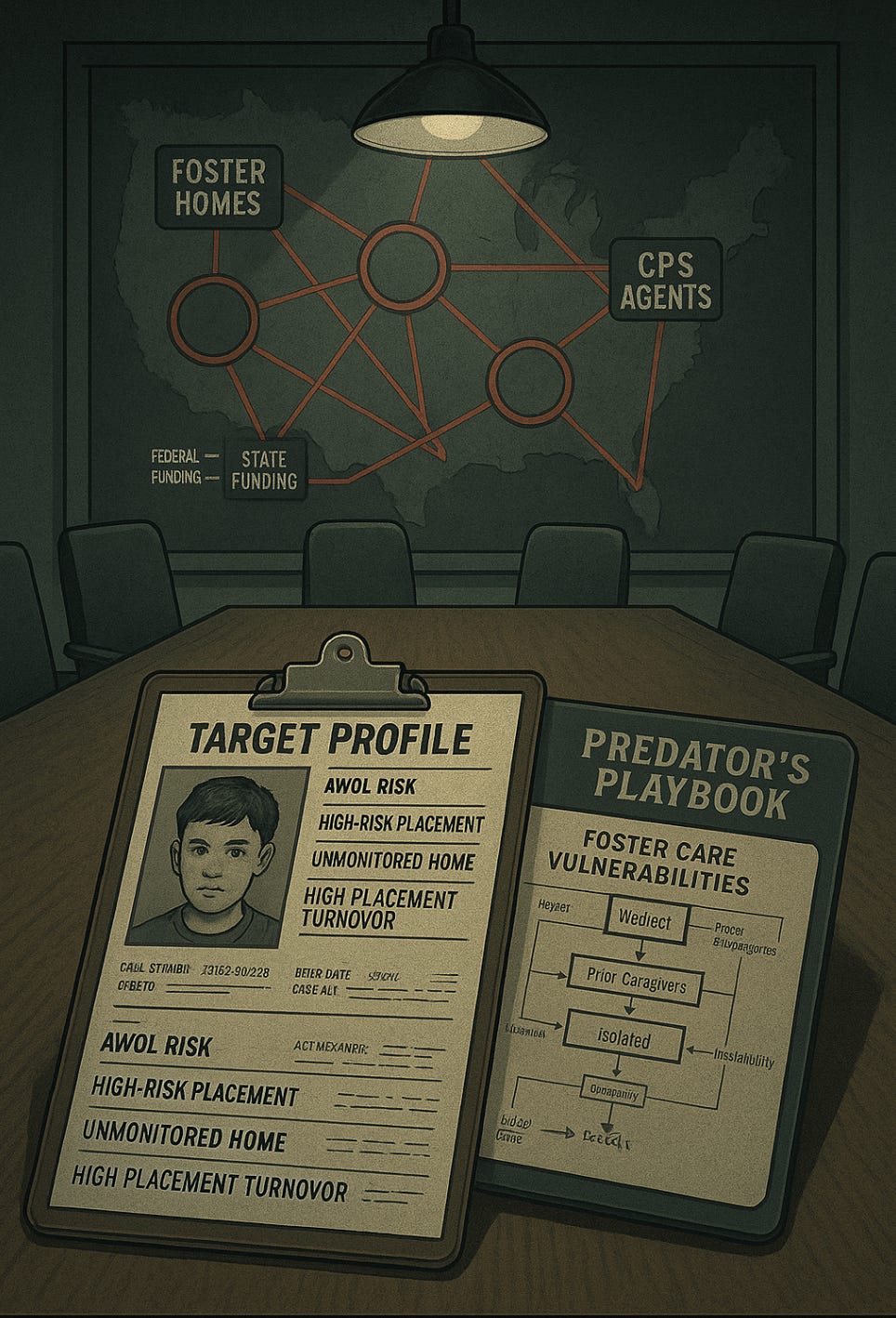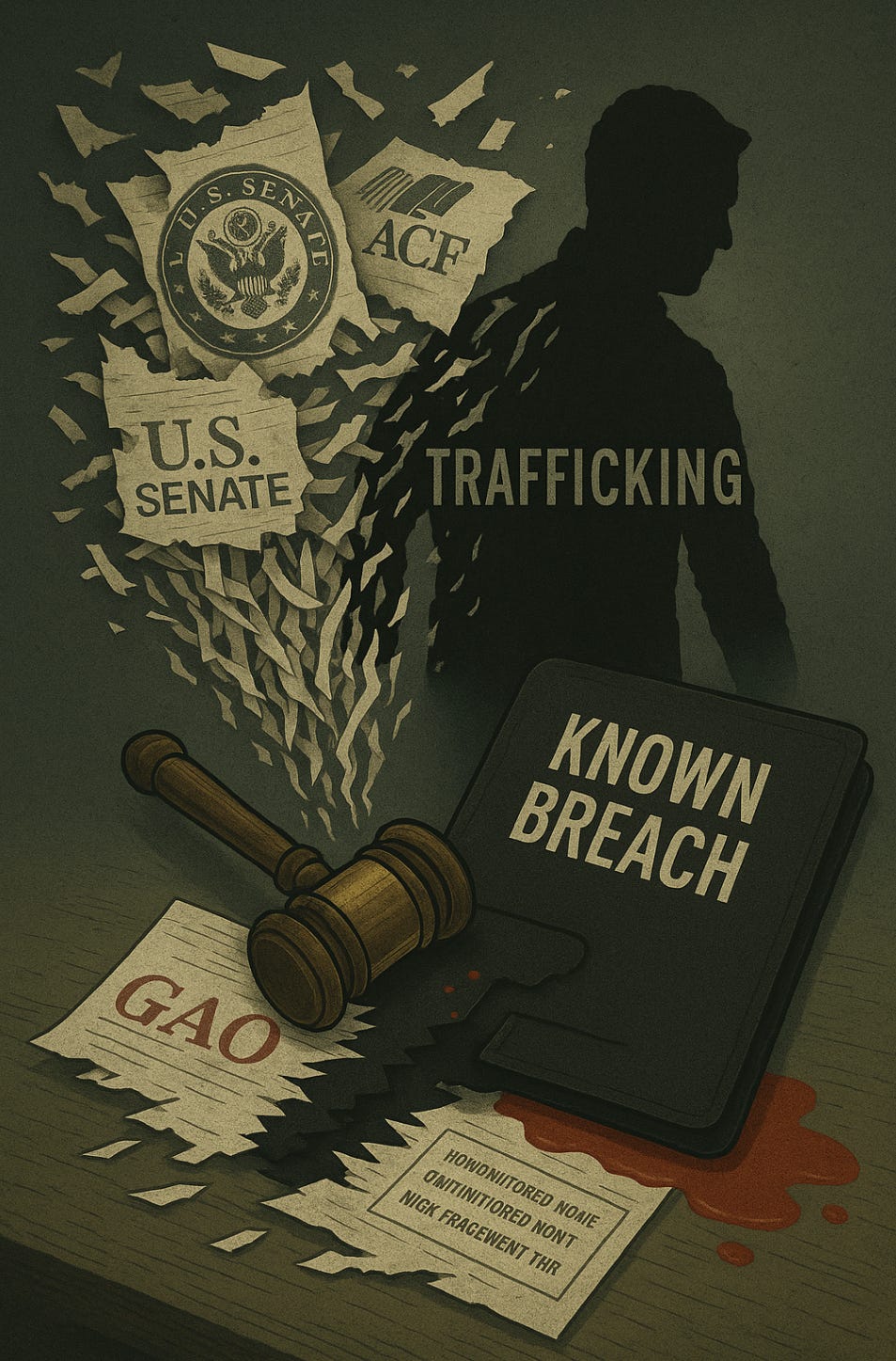Fosterware: Part 6, The Engineered System Behind America’s Child Removal Machine
Red Team the System: How Traffickers Exploit Fosterware
Section A - The Simulation
Section A – Red Team the System: The Simulation
“If you were planning a trafficking operation, would you pick random targets—or would you tap into a system that already locates, transports, and isolates vulnerable kids for you?”
In military and intelligence circles, Red Teaming is the process of thinking like the enemy. It’s how we pressure-test defenses, simulate breaches, and identify hidden vulnerabilities in our own systems. In child welfare, few dare to apply this approach. But when we Red Team Fosterware, we stop pretending it’s broken. We treat it as what it can be—a fully functional logistics platform vulnerable to exploitation by predators.
This isn’t speculation. It’s operational analysis. And the simulation succeeds with minimal effort.
Step 1: CPS Removes the Child
Every trafficking funnel needs access. Fosterware provides it. The removal process opens the door. Once a child is taken from their home by CPS, they are immediately inserted into a holding system:
Temporary shelters with overcrowded conditions and low staff-to-child ratios.
Foster homes, some licensed in name only.
Residential group facilities, often run by private contractors, some with histories of abuse allegations.
Oversight at this stage is paper-thin. Review boards are delayed. Caseworker visits are inconsistent. Many placements rely on unmonitored digital logs rather than physical welfare checks. Children are emotionally destabilized—fearful, grieving, desperate for connection. These children may have already experienced trauma from family separation, recent relocation, or multiple prior placements. It’s the ideal moment for a predator to enter.
Step 2: Contractor or Third-Party Gains Access
This is the breach point. The state often subcontracts out critical child welfare functions:
Transport services to and from court, school, or medical appointments.
Facility staffing through agencies that do not require child-specific vetting.
“Mentorship” or religious visitation programs with minimal background checks.
Private companies operating these services may operate across multiple facilities with little internal tracking or interagency auditing. A single individual with clearance to enter multiple homes or programs has potential access to dozens of isolated, emotionally compromised children on a rotating basis. In some state audits, contractors were found to have repeated contact with minors without proper credential checks or supervision, a direct pathway for grooming or exploitation.
In many states, third-party drivers or staff are hired at low pay, with weak background checks and no trauma-informed training. Their phones are not confiscated. Their routes are unmonitored. They operate largely unsupervised.
Step 3: Information Leak or Digital Vulnerability
The child’s profile is now active in the system. Fosterware platforms like SACWIS and Traverse store:
Case history
Family details
Mental health records
Behavioral profiles
Risk flags and prior placements
These are often accessible to dozens of actors—caseworkers, court staff, contractors, therapists, and sometimes volunteers. In multiple states, these systems have been criticized for lax security protocols, weak password protections, and failure to log user access history.
Traffickers don’t need to hack. They need an inside man—or a weak credential link. With access, they can:
Identify which children are most isolated.
Track placements with low oversight history.
Flag children with prior behavioral flags—those more likely to be dismissed as “problematic” if they go missing.
Information leakage doesn’t need to be a breach. It only requires familiarity with the system and soft infiltration. In known data incidents, staff have shared confidential case details via unsecured personal email, and former employees have retained access for weeks after termination.
Step 4: Displacement through “System Churn”
Once the child is flagged, contact is made. It might be emotional grooming. It might be coercion. Or it might be a coordinated pickup under the guise of transport or visitation.
Here’s the breakdown:
Children go missing during relocation between placements.
Others go AWOL from group homes—which may delay reporting for 24–72 hours.
Some “age out” of foster care without guardianship, support, or housing—and disappear off the books entirely.
Add to this the caseworker turnover crisis—with rates exceeding 30% annually in many jurisdictions—overburdened workers cycling in and out of jobs, leaving case notes incomplete and follow-ups abandoned. When files go cold, the child vanishes into a bureaucratic blind spot. No one notices. No one chases.
This isn’t a kidnapping. This is disappearance by design—enabled by system churn and covered by plausible deniability.
The perfect victim is the one no one is looking for. And Fosterware manufactures them by the thousands.
This simulation exposes the obvious:
Access is routine.
Oversight is absent.
Digital records are exploitable.
Churn erases accountability.
This is not a rare failure. This is a predictable breach. This is a tactical summary of how vulnerability is systematized and how the architecture of child welfare becomes a trafficking asset.
This is how a predator sees the system—and how easily they can use it.
Section - B – Government Reports Confirm the Exploitable Gaps
“When an exploit becomes predictable, it becomes operational. And Fosterware has become an operational risk vector—because the government knows it, and still it persists.”
The vulnerabilities within the U.S. foster care system are not theoretical—they are thoroughly documented. Over the past decade, multiple oversight bodies, including the Government Accountability Office (GAO) and the Department of Health and Human Services Office of Inspector General (HHS OIG), have exposed critical failings in how states manage children in state custody. These are not isolated incidents. They reveal exploitable weaknesses that directly align with the Red Team simulation of Fosterware as a trafficking-prone ecosystem.
1. GAO Report on Abuse in Residential Facilities (2024)
The GAO reported that children in foster care placed in residential treatment facilities were subjected to physical, emotional, and sexual abuse by staff. Despite these incidents, many remained in the same placements without intervention or investigation. Oversight failures and communication breakdowns between state agencies allowed abusive conditions to persist unchecked.
📄 GAO-24-107625: Youth Facilities Oversight Gaps
2. HHS OIG Report on Missing Children and Sex Trafficking Risks (2022)
An HHS OIG investigation found that in five sampled states, 65% of case files lacked documented screenings for sex trafficking upon the return of children who had gone missing from care. This missing protocol leaves children vulnerable to re-exploitation and indicates serious noncompliance with federal anti-trafficking mandates.
📄 OIG Report: In Five States, No Evidence of Sex Trafficking Screening
3. HHS OIG Audit on Unreported Missing Children (2023)
Another HHS OIG audit revealed that state agencies failed to report thousands of missing foster youth to the National Center for Missing and Exploited Children (NCMEC), in direct violation of federal law. Without this reporting, law enforcement and national child protection networks are left blind to disappearances—effectively creating a bureaucratic blackout zone.
📄 OIG Report: Missing Foster Children Not Reported to NCMEC
4. U.S. Senate Investigation on Residential Treatment Centers (2024)
A bipartisan Senate investigation described residential treatment centers—where many children removed by CPS are housed—as “warehouses of neglect.” The report found children subjected to over-drugging, isolation, and violence. These centers, often privatized, have financial incentives to keep beds filled and oversight thin.
📄 Senate Report: Warehouses of Neglect – Residential Treatment Failures
These findings are not fringe. They confirm the key assertions of the Red Team simulation:
Fosterware’s infrastructure lacks proper oversight.
Critical information systems are uncoordinated or ignored.
Accountability is routinely deferred in favor of systemic preservation.
Exploitable conditions are normalized, not corrected.
The U.S. foster care system has been warned—repeatedly. The threat is documented.
The breaches are mapped.
When nothing is done, it's no longer negligence. It's design.
No Interagency Coordination = No Accountability
In theory:
CPS reports to state DHS.
Foster facilities licensed by state agencies.
Missing children reported to local police.
Trafficking monitored by DOJ and DHS.
In practice:
No shared data pipelines.
Jurisdictional disputes.
Contracted facilities dodge oversight by shifting locations or changing names.
Law enforcement often dismisses missing youth as “runaways.”
This is a fragmented kill zone, where each agency blames the other, and the child disappears between the cracks.
Summary: The System Is Not Just Abusable—It’s Ideal
Fosterware creates the intake.
Contracted providers create the access.
Interagency fragmentation creates the shield.
“From a Red Team perspective, Fosterware isn’t a barrier to trafficking—it’s a turnkey infrastructure for it.”
Continue to Part 7




I was one of these children one of the missing that was dismissed as problematic and behavioral,I just want to thank you and your team for bringing honest writings about difficult subjects to the public , please continue to do what so many don’t have the courage or knowledge to do .i appreciate on so many ways your words, in a big way it gives words to the voiceless ones out there that often are dismissed as disobedient throughout some of the most traumatic and complicated times of there lives. Reading this has reminded me that humanity has a chance if only given the opportunity to learn what they have not experienced themselves, thanks for doing what you do ..
Why report missing kids? The money might go missing